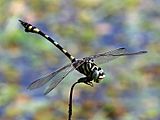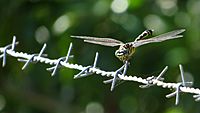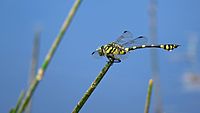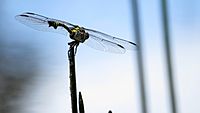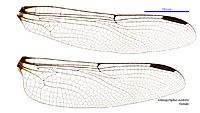Ictinogomphus australis facts for kids
Quick facts for kids Ictinogomphus australis |
|
|---|---|
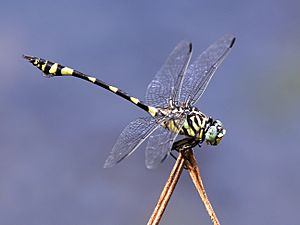 |
|
| Male, Cairns, Australia | |
| Conservation status | |
| Scientific classification | |
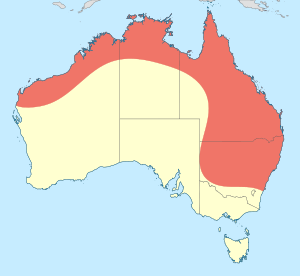 |
The Ictinogomphus australis, also known as the Australian tiger dragonfly, is a fascinating insect. It belongs to the dragonfly family called Lindeniidae. These dragonflies are quite large. They can have a wingspan of up to 100 millimeters (about 4 inches). Their bodies can grow to 70 millimeters long (about 2.7 inches).
You can easily spot them by their bright yellow and black colors. They have clear wings that help them fly fast. Their eyes are set wide apart on the top of their heads. This helps them see all around while hunting.
Contents
About the Australian Tiger Dragonfly
The Australian tiger dragonfly is a unique creature. It was first described by a scientist named Edmond de Sélys Longchamps in 1873. These dragonflies used to be part of a different family, the Gomphidae. But now, they are in the Lindeniidae family.
Where They Live
You can find these amazing dragonflies near water. They love places like rivers, lagoons, lakes, and ponds. These watery spots are perfect for them to hunt and lay their eggs. They need clean water to survive.
What They Look Like
Australian tiger dragonflies are known for their striking colors. Their bodies are a mix of bright yellow and black. This makes them stand out. Their wings are clear, like glass. They are very strong flyers.
You can tell the difference between male and female dragonflies. Males have two special curved flaps. These flaps are found under the eighth part of their abdomen. This is a key way to identify them.
Where to Find Them in Australia
These dragonflies live across a large part of Australia. They are found in an arc shape. This arc stretches from Broome, Western Australia in the west. It goes all along the northern coast. Then it extends down to Point Hicks in the south-east corner. This wide range shows they can adapt to different environments.
Conservation Status
The Australian tiger dragonfly is doing well. Scientists have checked its population. It is listed as being of least concern on the IUCN Red List. This means their numbers are stable. They are not currently at risk of disappearing. This is good news for these beautiful insects.
Gallery



